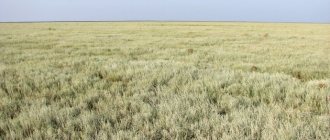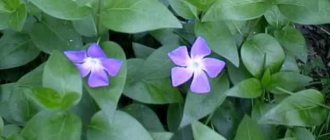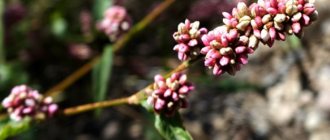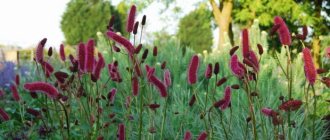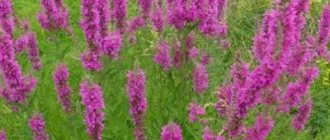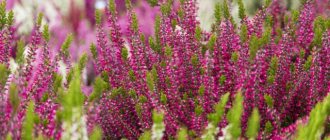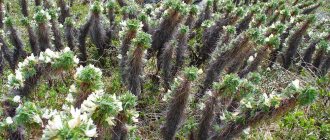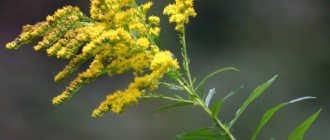Chernogolovka is a plant known since ancient times. It was distributed on all continents and was used by many witch doctors and healers. Currently, blackhead, being a wild species, has not lost its popularity and is used to treat many ailments, as it has broad therapeutic activity, a rich chemical composition and a sufficient raw material base. The Latin name (Prunella vulgaris) can be translated as “burning ember”. Perhaps the name was given because the inflorescence resembles a coal that is about to fade away.
Characteristic
The common blackhead plant belongs to the Lamiaceae family. The culture is unpretentious, does not require care, grows well in its natural environment, covering the ground with a carpet of greenery with purple ears. Its stem is erect, raised, branched. The upper leaves are sessile, the lower leaves are petiolate.
The inflorescence has an ovoid or elongated shape. It consists of false rings formed from fleecy bracts. Each layer contains six flowers. Their two-lipped calyxes are green or purple. The corollas are usually purple. There are four stamens inside. The flower is designed in such a way that it protects the nectar with a fleecy fence from small insects, preserving it for pollinating bees.
Chernogolovka is a honey plant. It is estimated that up to 90 kg of nectar can be collected from one hectare. After pollination is complete, the corollas dry out and fall out, and the bare ears during this period can be compared to miniature ears of corn.
In place of the stamens, four nut-shaped seeds are formed in each calyx. But it is not advisable to use them for propagation in culture. It is much easier to do this with root cuttings, which take root well and produce numerous shoots.
As the root system grows, it loosens the soil well, giving access to oxygen and moisture, facilitating the penetration of beneficial microflora into the soil. The flowering season lasts a long time; in some places it begins in late spring and can last until warm autumn.
Brief description of the common blackhead:
Common blackhead (black gourd)
is a perennial herbaceous plant up to 30 cm high, glabrous or sparsely pubescent. The stem is ascending, tetrahedral, brown, weakly branched.
The leaves are opposite, petiolate, ovate, obtuse, entire or finely crenate, the upper pair of leaves is located directly under the inflorescence. The flowers are symmetrical, located in the axils of ovoid, pointed bracts and form an apical false spike. The calyx is two-lipped, with 5 teeth. The corolla is blue-violet, less often yellow-white, two-lipped, twice as long as the calyx, with a pubescent upper lip. The fruit is a composite of 4 nuts, small, hard, located in a preserved calyx.
Blooms from May to October.
Spreading
Chernogolovka is a plant found even in Arctic regions. It grows confidently in Siberia and is present in the Far East and the Caucasus. It is especially common in China. It grows everywhere in central and southern Europe and Asia. You can find it in North Africa and America, Japan, India, Mongolia, and Australia.
It can be found in dry regions and in humid places, on plains and in mountainous areas. It grows on the edges of forests, meadows, fields, ravines, along the banks of lakes, rivers and swamps. It is considered a weed and can be a nuisance in cultivated areas, as it self-seeds and grows aggressively.
It can be bred as a ground cover species or grown for the preparation of medicinal raw materials. Prefers partial shade and grows especially well in mulched soil. Under suitable conditions, the seeds germinate the same year in August, and by October they have already formed a leafy rosette. Young plants overwinter well. Ungerminated seeds sprout in May.
Although blackhead is used in livestock feeding with restrictions, many animals in the natural environment readily eat it. There is even an opinion to include this species in the list of substances safe for use.
Compound
Chernogolovka is a plant that is almost never used in official medicine. Its composition has not been studied well enough. However, available data indicate its high therapeutic properties due to the presence of biologically active substances.
The above-ground part of plants is rich in flavonoids: quercetin, rutinin, hyperoside, kaempferol. Also present are coumarins, saponins, tannins, resins, bitterness, essential oils and organic acids. There is boron, copper, manganese, zinc, potassium, as well as a lot of ascorbic acid and carotene.
This alone is enough to talk about the prospect of studying the plant with the aim of using it to create medicines.
Procurement of raw materials: common blackheads
The medicinal plant is harvested during flowering. All above-ground parts are used: leaves, stems and inflorescences. To collect raw materials, choose places away from fields treated with herbicides, and also not along roads with heavy traffic, since the plant can accumulate heavy metal compounds and other toxic substances.
It is better to use the collected material fresh. Can be dried in the shade in a well-ventilated place and stored for up to six months. The time for procurement of raw materials is from July to September.
Rules for collecting, drying blackheads, storage requirements
For treatment, the entire above-ground part of the brunette is used - flowers, leaves, shoots. It is recommended to collect the healing element for preparing homemade medicines in the summer, during flowering time.
Autumn raw materials are not collected - the amount of useful elements is significantly reduced, the plant begins to accumulate toxic substances harmful to human health.
Finely chop the greens along with the flowers at home (it is better to immediately pick off some of the flowers and dry them separately - some home remedies are prepared only on the basis of this part of the herb), spread them in a thin layer on special racks and paper-lined baking sheets.
Article for you:
Herb Ivan-tea - medicinal properties and contraindications
It is recommended to dry plant materials in ventilated attics, under canopies. Avoid direct sunlight, which can destroy beneficial compounds. It is also allowed to use electric dryers and ovens, the optimal temperature is 45-50 degrees.
After drying, package the dry herb in glass, cardboard, or plastic containers. If there is a dry, cool room, packaging in cardboard boxes is allowed. The medicinal properties of blackhead last for two years.
The medicinal qualities of the herb are not officially recognized; herbal raw materials or preparations based on Brunelle are not sold in pharmacies. For treatment, you will have to collect and dry the grass yourself.
Chernogolovka: properties of blackhead, application
In China and Korean medicine, herbalists use this plant as a panacea for many diseases. The active substances it contains suppress the growth of E. coli and pathogens of tuberculosis and typhoid fever. For these abilities, the plant is considered as an alternative to antibiotics. It is also used as an antipyretic, hemostatic, antispasmodic and analgesic.
There is evidence of the antiviral activity of blackhead extract. In particular, studies were conducted on the activity of the polysaccharide prunelin against the immunodeficiency virus. It was found that according to certain indicators it is more effective than retrovir. Eye drops of the extract had a positive effect on the treatment of viral keratitis.
Organic acids influence the normalization of hormones responsible for the condition of the thyroid gland. High immunomodulatory activity of blackhead has been noted. Preparations from this plant have a beneficial effect on blood vessels and thereby gently regulate blood pressure.
Contraindications to the use of blackhead, side effects
Chernogolovka has a number of contraindications, which are best taken into account before starting a course of alternative treatment. The main prohibition is pregnancy.
The plant contains substances that can negatively affect the development and condition of the fetus, provoke miscarriage, and cause serious allergic reactions in the expectant mother.
Article for you:
Medicinal properties of Japanese Sophora, contraindications and use of traditional medicine
During lactation, you will also have to stop consuming herbal compounds - with mother’s milk, elements dangerous to the baby will penetrate into the small body, which can result in serious poisoning.
Herbal formulations will also cause harm in case of individual intolerance to the herb or chronic diseases of the digestive tract. It is strictly forbidden to give herbal remedies to children; treatment is allowed to begin only after 14 years of age, after consulting a doctor.
Side effects with the correct use of plant materials and the absence of prohibitions are rarely alarming. The main unpleasant manifestations are cutting pain in the abdominal area, severe headaches (often resulting in dizziness, even fainting), nausea, vomiting, and problems with urination. The dermis reacts with rashes, changes in tone, and discomfort in the form of burning and itching.
Usage
Blackhead has been successfully used as a mild natural antihypertensive and diuretic in the treatment of hypertension in the initial phase. Herbaceous plants are harvested and dried for brewing tea in their pure form or used as part of tea preparations. Such decoctions will also be useful for rinsing with mouth ulcers and inflammatory processes of the gums.
Infusions and extracts are prepared from the flowers. They can be added to ointments, creams and lotions for the treatment of dermatitis of various etiologies. Fresh juice is preserved by diluting it with vodka or alcohol. For seborrhea, washing your hair with a decoction of blackhead herb is recommended. For various skin inflammations, it is used to add to baths. For sore throats, gargle with the infusion. The steamed herb is used as a remedy to combat dandruff.
Treatment of joint diseases with tincture of blackhead
A tincture prepared at home based on herbs is an effective medicine against joint ailments. The product quickly relieves inflammation, severe pain, swelling, and restores mobility.
Article for you:
Medicinal properties of wintergreen and its use in folk medicine
The plant also contains substances that saturate bone tissue, strengthen it, and increase elasticity. It is recommended to use the tincture for medicinal and preventive purposes. Step by step recipe:
- Chop the greens of the plant (100 g) and place in a glass container (it is better to use a dark glass bottle).
- Pour the vegetable mixture with pervach and vodka (400 ml), stir.
- Seal the container tightly and place it in the basement or cellar.
- Infuse for half a month, periodically shaking the contents of the bottle.
- Strain, fill a clean container, and place in the refrigerator.
Use the tincture to rub painful areas. Massage the skin until the composition is completely absorbed. If the disease is serious, spreads rapidly, and affects healthy tissue, use a compress.
Soak a clean cloth with liquid, place it on the painful area (squeeze it out a little first), secure with plastic wrap (use only food-grade polyethylene, which allows the dermis to breathe). Wrap a towel or scarf over the joint and leave the compress until the morning.
Recipes
Different countries have their own characteristics and even traditions of using this plant. The flower (perennial blackhead) was used not only in the treatment of ailments, but also for the prevention of various diseases. So the Cherokee and Thompson Indians, soaking it in cold water, received a good tonic drink. The leaves were used to prepare dishes with boiled vegetables, and when dried, as a seasoning. The juice was rubbed onto the temples to treat headaches, and also applied to insect bites to relieve swelling and alleviate the condition. The steamed herb was applied to the skin for burns.
In Ireland, tea was brewed from blackheads and St. John's wort for use against hypertension and diseases of the cardiovascular system. It was believed that such a drink relieves fatigue, tones, calms during excessive activity, and reduces losses during menstrual bleeding.
Blackhead tea with wine was successfully used to restore strength after protracted illnesses. It was recommended to be consumed in the spring to increase immunity and the body’s resistance to colds in cases of vitamin deficiency or outbreaks of infectious diseases. The bitterness in fresh leaves due to the high tannin content can be removed by soaking them in cold water. The stems and flowers contain a natural dye that gives an olive color when applied.
conclusions
Common blackhead should be taken orally with caution and after consultation with an appropriate specialist. We can talk about the great benefits of this plant, since the blackhead is widespread and easily grown in culture. At the same time, it gives a high yield of natural medicinal raw materials with high therapeutic properties and biological activity.
The plant can be used as a natural immunomodulator, which, in addition, has the property of toning the body, providing it with hepatoprotective, antiviral, adaptogenic and anti-inflammatory effects.
